1 Development of purulent appendicitis
Phlegmonous appendicitis is an acute surgical pathology, in which purulent inflammation of the appendix of the cecum is observed. The latter is a vestigial organ. He does not play any role in the process of digestion. Appendicitis occurs in 4 stages. Initially, catarrhal inflammation develops, and then - phlegmonous inflammation.
Do you have gastritis?
GALINA SAVINA: "How easy is it to cure gastritis at home for 1 month. A proven method - write down a recipe. ..!"Read more & gt; & gt;
The whole thickness of the appendix is involved in the process. In the lumen, pus is formed. This pathology develops in 6-24 hours from the time of the first complaints. In the absence of proper care, phlegmonous inflammation becomes gangrenous, which is fraught with perforation of the intestinal wall. The prevalence of acute appendicitis is very high.
The incidence rate is about 4-5 cases per 1000. More than 50% of all ambulance calls are associated with this intestinal pathology. The most common phlegmonous form of appendicitis is diagnosed in young people under 33 years old. Often sick teenagers. In women, inflammation of the appendix is observed 2 times more often. Often, this disease affects pregnant women. The older the person, the lower the risk of appendicitis.
2 Important etiological factors
The exact causes of the disease are not established. Possible etiologic factors are:
- occlusion of the process with calculous stones;
- stool disorder;Inaccuracies in the diet;
- proliferation of lymphoid tissue;
- parasitic diseases;
- thrombosis;
- allergic reactions;
- congenital malformations;
- foci of infection;
- hereditary predisposition;
- atherosclerosis.
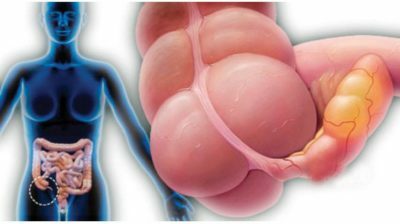
Recommended to read
- Consequences of apoplexy of appendix
- Treatment of peritonitis
- Functions and anatomy of appendix
- Effective agent for gastritis and stomach ulcer
In women, gynecological diseases( salpingo-oophoritis) can become a cause of acute phlegmonous appendicitis. A healthy person in the vermiform appendage forms mucus. It flows down into the lumen of the intestine. When the process is blocked, this process is broken. The accumulation of mucus leads to an extension of the appendix and its inflammation.
Occlusion is possible with a tumor, helminthiases and the presence of stool stones. The latter are formed with malnutrition, when food is retained for a long time in the intestine. The risk of developing acute phlegmonous appendicitis is increased when there is a shortage of vegetable products( vegetables, fruits, berries) in the diet. All this causes constipation and the formation of stones.
In many patients during the operation, helminths( pinworms, roundworms) are found in the lumen of the appendix. This indicates the role of parasites in the development of inflammation. Suppuration with phlegmonous appendicitis is caused by infection. Favorable factors for the reproduction of bacteria are injuries, the presence of adhesions, intestinal surgery, dysbacteriosis, colitis and cholecystitis.
-
 IMPORTANT TO KNOW! Gastritis? Ulcer? To have a stomach ulcer not turned into cancer, drink a glass. ..Read the article & gt; & gt;
IMPORTANT TO KNOW! Gastritis? Ulcer? To have a stomach ulcer not turned into cancer, drink a glass. ..Read the article & gt; & gt;
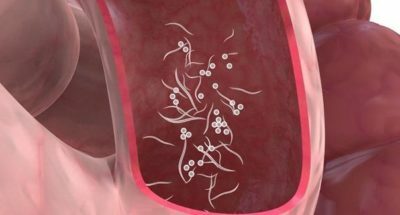
Most often, microbes get into the appendix through the blood and lymph. Against the background of inflammation, there is a thickening of the shoots. They are covered with a layer of fibrin. Formation of effusion. Pus accumulates in the cavity of the appendage. It is green and consists of living and dead cells( bacteria, lymphocytes, macrophages).Sometimes ulcers are formed. In some cases, empyema occurs. The risk of appendicitis increases with alcoholism, stress and hypodynamia.
3 Manifestations of the acute form of the disease
With phlegmonous inflammation of the appendix, the following symptoms are observed:
- pain;
- nausea;
- lack of appetite;
- fever;
- stool disorder by type of constipation;
- tension of abdominal muscles.

The first complaints appear in the early morning or at night. The main symptom is pain. It has the following distinguishing features:
- is felt in the lower abdomen on the right side;
- constant;
- is strong;
- can be pulsating;
- is spilled over the entire abdomen;
- is prone to amplification;
- is combined with nausea;
- intensifies during coughing, running and jumping.
-
 Gastroenterologist. IMPORTANT: "I beg you, if you began to worry about abdominal pain, heartburn, nausea, do not in any way do gases. .."Read more & gt; & gt;
Gastroenterologist. IMPORTANT: "I beg you, if you began to worry about abdominal pain, heartburn, nausea, do not in any way do gases. .."Read more & gt; & gt;
This symptom is caused by inflammation of the appendix tissues and irritation of the nerve endings. In the first hours the pain is spilled. The patient can not accurately determine its localization. After a few hours, it moves to the right. Complaints increase when a person lies down on his right side. At first, the pain is acute and cramping, then it becomes blunt or burning.
Often a person takes a forced position of the body. He lies down on his right side and draws his knees to his stomach. If the necrosis of tissues occurs, the pain subsides temporarily. After a breakthrough of pus, it reappears. The reason is irritation of the peritoneum. The localization of pain varies. It depends on the location of the appendix. If it lies incorrectly, then pain can occur in the suprapubic zone or in the hypochondrium. This makes it difficult to diagnose.
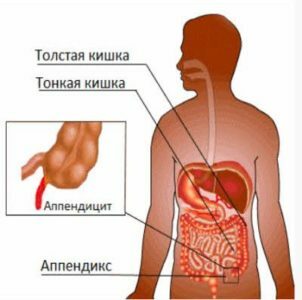
Almost every patient with phlegmonous inflammation of the appendage has nausea. Each second patient has constipation. Diarrhea is less common. Vomiting with phlegmonous inflammation is rare. The body temperature rises to +38. .. + 38.5ºC.Sometimes it stays within the norm. The cause of fever is intoxication of the body. A frequent sign of appendicitis in children and adults is the tenderness of the abdomen during palpation. In pregnant women, the disease proceeds in an erased form.
ADVICE FROM THE MAIN GASTROENTEROLOGIST
Korotov SV: "I can recommend only one remedy for the rapid treatment of Ulcer and Gastritis, which is now recommended by the Ministry of Health. .." Read testimonials & gt; & gt;
4 Possible complications
Phlegmonous inflammation of the appendix in case of incorrect treatment or delayed treatment to the doctor can lead to serious consequences. The following complications are possible:
- formation of an appendicular infiltrate;
- portal portal lesion;
- peritonitis;
- formation of abscess in the abdominal cavity.
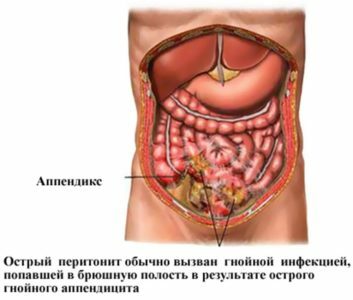
The danger to human life is such a condition as peritonitis. When it is inflamed, the wall of the peritoneum. This is fraught with the development of sepsis and the death of a person. The reason for the development of peritonitis is the penetration of pus into the abdominal cavity. A rare complication is pylephlebitis. This is an inflammation of the portal portal wall. Sometimes appendicitis becomes the cause of thrombosis.
Untimely treatment can lead to a fusion of the process with intestinal loops and omentum. So an appendicular infiltrate is formed. Its presence makes the operation difficult. Melt infiltration leads to the formation of an abscess. This is a cavity with pus. Abscesses are subject to mandatory autopsy.
5 Patient survey plan for
When suspected of acute phlegmonous appendicitis, the following tests are performed:
- palpation of the abdomen;
- ultrasound of the abdominal cavity;
- general clinical analyzes;
- definition of specific symptoms;
- fluoroscopic examination;
- computed tomography;
- laparoscopy.
WE RECOMMEND!
For prevention and treatment of Digestive Diseases our readers advise Monastic tea. This unique remedy consists of 9 medicinal herbs useful for digestion, which not only supplement, but also strengthen each other's actions. Monastic tea will not only eliminate all symptoms of the gastrointestinal tract and digestive system, but will also permanently eliminate the cause of its occurrence.
Opinion of doctors. .. "

The following changes are revealed on examination:
- abdominal tenderness;
- is a positive symptom of irritation of the peritoneum;
- pain relief on the left side;
- lagging of the tongue;
- pallor of the skin;
- flattening of the abdomen;
- tension of abdominal muscles.
In the course of laboratory studies, leukocytosis is detected. Therapeutic and diagnostic measures include laparoscopy. If there is a suspicion of complications, a CT scan is performed. Exclude other infectious and inflammatory diseases allows ultrasound. Differential diagnosis is performed with acute cholecystitis, pancreatitis, perforated ulcer of stomach and duodenum, renal colic, adnexitis, ectopic pregnancy and rupture of the ovary. It is necessary to exclude urolithiasis.
6 Methods of treatment
In case of severe pain syndrome, before visiting a doctor, it is best not to take painkillers. You can use antispasmodics. When purulent inflammation of the appendix does not apply warmers and warm compresses. If the pain lasts more than 6 hours, then you need to call an ambulance. The main method of treating the phlegmonous form of appendicitis is surgery.
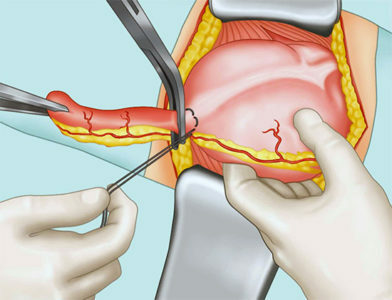
It is conducted under general anesthesia. Subdural anesthesia is widely used. The incision is made in the iliac region to the right. The process is removed with a scalpel. Ligature is mandatory. If necessary, an antibiotic is administered. Sometimes install a drain. This is an open operation. Currently, laparoscopy is widely used.
Its advantage is that it does not require a large cut. A puncture is made in the abdomen. Through it, a tube with a camera is installed. The doctor on the screen sees all the manipulations being carried out. This is a gentle operation. After her, the person is discharged after 2-3 days. Laparoscopy allows not only to remove the appendix, but also assess the condition of other organs of the abdominal cavity.
After treatment, a course of antibiotic therapy is conducted. This is done with a preventive purpose to prevent postoperative complications. If spinal anesthesia was used, then after a surgical intervention you need to drink more. This is a simple prophylaxis of thrombosis. Patients need to adhere to proper nutrition.
The diet is aimed at preventing constipation and bloating. The prognosis with the phlegmonous form of appendicitis is favorable. Lethal cases are rare. Complications develop in 5-9% of patients. The most common is peritonitis. The risk of recurrence after surgery is absent, since the process is completely removed.
Conservative treatment is ineffective. The use of folk remedies can cause complications. Thus, the phlegmonous form of appendicitis is diagnosed very often. To prevent the disease, you need to normalize the stool, treat parasitic and other infectious diseases, exclude alcohol and lead a mobile lifestyle.
- 1 Development of purulent appendicitis
- 2 Important etiological factors
- 3 Acute illness
- 4 Possible complications
- 5 Patient survey plan
- 6 Treatment methods
The group of acute diseases of the abdominal cavity includes phlegmonous appendicitis. This pathology, in which the vermiform appendix is inflamed. This condition requires surgical intervention. Conservative treatment is ineffective.



